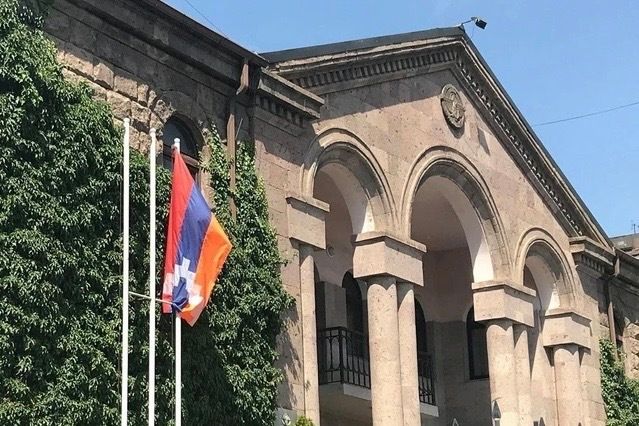
Nagorno-Karabakh’s last president, Samvel Shahramanyan, has filed a lawsuit demanding Armenia refutes parts of a 9th grade history textbook suggesting that he had signed a decree dissolving the Nagorno-Karabakh Republic in 2023.
On Tuesday, Shahramanyan filed his defamation lawsuit against the Education Ministry and the author of the relevant section in the textbook, Nzhdeh Hovesepyan, CivilNet reported.
Shahramanyan labelled the information saying that he ‘signed a decree to dissolve’ Nagorno-Karabakh as ‘false and not true’.
With the lawsuit, he requested the court oblige the ministry and the author to refute the information publicly by ‘all possible means, including by including the rebuttal in an educational programme’, CivilNet reports.
He further provided a lengthy text for the refutation in which he appeared to contradict himself.
Shahramanyan signed a decree ordering the dissolution of Nagorno-Karabakh following its surrender in the face of Azerbaijan’s final offensive against it in September 2023. The decree stipulated that the republic would be dissolved by 1 January 2024, and was published by the Nagorno-Karabakh Info Centre, an official government source which is no longer available.

In the lawsuit, Shahramanyan elaborates on the consequences under which the decree was made in September 2023.
He suggested that following the last Azerbaijani attack on the region, Azerbaijan ‘with a direct demand and threat of massacre of the population’, suggested he convene a session of parliament and adopt a declaration on Nagorno-Karabakh’s dissolution.
However, Shahramanyan refused to act, ‘realising the legal, political, and historical consequences of such a step’, and reportedly told the Azerbaijani side that ‘it was impossible to ensure a parliamentary quorum’.
As Azerbaijan insisted, Shahramanyan reportedly ‘proposed replacing the declaration with a decree adopted by him’, taking into account ‘the seriousness of the situation’ and the ‘fact of the blockade’.
Prior to Azerbaijan’s assault, Nagorno-Karabakh had been under a nine-month blockade by Azerbaijan, as supplies dwindled in the region.
In his refutation published on 28 September 2023 , Shahramanyan claimed that Nagorno-Karabakh published information on the adoption of the decree, ‘despite not having adopted such a decree’. The following paragraph, however, makes a seemingly contradictory statement, implying that such a decree did, in fact, exist.
‘After moving to Armenia, in order to avoid further speculation, the President of the Republic of Artsakh [Nagorno-Karabakh], Samvel Shahramanyan, adopted a decree’ by which he declared ‘invalid’ the issued decree on the dissolution, the statement read.
It further concluded that ‘neither this decree nor any statement about the decree on the dissolution’ of the republic had any legal force, as it contradicted the constitution of the region, as well as the provisions of other legal acts ‘having higher legal force than the decree’.
Armenian officials have been hostile to proposals for a Nagorno-Karabakh government in exile based in Armenia, warning it could be used by Azerbaijan as a pretext to take military action against Armenia.
Despite the stance of the Armenian authorities, in April, ahead of the last president of Nagorno-Karabakh’s term ending in May, former MPs from the region convened a session to regulate the issue of the president’s continued tenure through legislative amendments.
In response, Armenia’s ruling Civil Contract party called the move ‘extremely unacceptable’.

For ease of reading, we choose not to use qualifiers such as ‘de facto’, ‘unrecognised’, or ‘partially recognised’ when discussing institutions or political positions within Abkhazia, Nagorno-Karabakh, and South Ossetia. This does not imply a position on their status.











